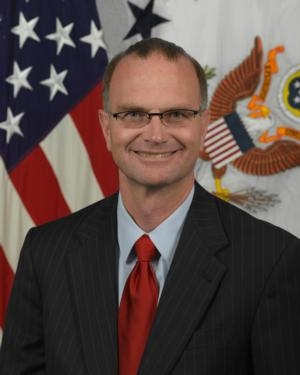Fri, Jun 08, 2012
U.S. Has 'Fine-Tuned' Methods To Promote Responsible Use Of Space
The U.S. has fine-tuned its methods to promote responsible use of space and strengthen international partnerships, Ambassador Gregory L. Schulte, the deputy assistant secretary of defense for space policy, said during the 2012 Women in Aerospace Conference June 1. In his keynote address at the conference, Schulte outlined the plan to protect U.S. advantages and sustainability in space as directed by the National Security Strategy for Space issued by Defense Secretary Leon E. Panetta and national intelligence officials.

"Space is no longer a pristine environment," Schulte (pictured) said. "We have to think differently about how we cooperate with others in space."
Schulte explained that burgeoning interest in space by a number of nations is both an asset and a liability. "Allied capabilities can augment ours, add resilience and increase our ability to operate in a contested space environment when adversaries may be trying to take away our space capabilities," he said. "As there are more and more actors in space, it becomes more important that we bring a certain amount of order to that domain, that we encourage countries to act responsibly." As such, Schulte said, Secretary of State Hillary Rodham Clinton and U.S. Strategic Command, based at Offutt Air Force Base, Neb., have weighed in this year to take deliberate steps in negotiating space situational awareness agreements with countries across the globe.
The discussions have united the "European Union and other space-faring countries to develop an international voluntary code of conduct meant to encourage countries to act responsibly and call out those who act irresponsibly," Schulte said.
The norms, Schulte asserts, aim to help U.S. and coalition countries share information on an emergency basis, encourage best practices to buffer the uptick of mishaps and control the creation of additional debris in space. "(STRATCOM) tracks over 20,000 pieces of debris -- and that's just what they can see," Schulte said. "NASA estimates there are probably hundreds of thousands of pieces of debris up there."
Harnessing international partnerships also includes a plan to expand the Joint Space Operations Center at Vandenberg Air Force Base, Calif., into a coalition asset by integrating Canada's first operational military space-based telescope system, Sapphire. A larger constellation of satellites supplied by international partner nations provides greater coverage and bandwidth, Schulte said, and also creates an international space alliance that can act as a deterrent to threats against the U.S. and its allies.
More News
Circle To Runway (Runway Number) Used by ATC to inform the pilot that he/she must circle to land because the runway in use is other than the runway aligned with the instrument appr>[...]
Aero Linx: National Aviation Safety Foundation (NASF) The National Aviation Safety Foundation is a support group whose objective is to enhance aviation safety through educational p>[...]
At Altitude Of About 250-300 Ft Agl, The Airplane Experienced A Total Loss Of Engine Power On November 6, 2024, at 1600 central standard time, a De Havilland DHC-1, N420TD, was inv>[...]
From 2009 (YouTube Edition): Three Hour Flight Was 'Flawless' -- At Least, Until Mother Nature Intervened For anyone who loves the aviation business, this was a VERY good day. Afte>[...]
Also: AMA Names Tyler Dobbs, More Falcon 9 Ops, Firefly Launch Unsuccessful, Autonomous F-16s The Air Force has begun ground testing a future uncrewed jet design in a milestone tow>[...]
 ANN's Daily Aero-Term (05.05.25): Circle To Runway (Runway Number)
ANN's Daily Aero-Term (05.05.25): Circle To Runway (Runway Number) ANN's Daily Aero-Linx (05.05.25)
ANN's Daily Aero-Linx (05.05.25) NTSB Prelim: De Havilland DHC-1
NTSB Prelim: De Havilland DHC-1 Classic Aero-TV: The Boeing Dreamliner -- Historic First Flight Coverage
Classic Aero-TV: The Boeing Dreamliner -- Historic First Flight Coverage Airborne-NextGen 05.06.25: AF Uncrewed Fighters, Drones v Planes, Joby Crew Test
Airborne-NextGen 05.06.25: AF Uncrewed Fighters, Drones v Planes, Joby Crew Test



